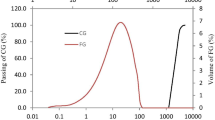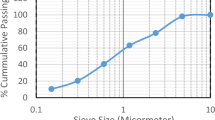Abstract
In order to find new application fields for either fine materials coming from building demolition or industrial byproducts, some mortars, in which fine recycled materials, obtained from a plant where rubble from building demolition are ground, are substituted to natural sand, were tested.
Moreover, mortars containing either fly ash or ground brick powder as partial cement replacement were studied.
Based on characterization results and performance evaluations, recycled-aggregate mortar seems to be superior in terms of mortar-brick bond strength, mainly because of its rheological properties.
In addition, the use of fine recycled aggregate instead of natural sand is in accordance with the sustainable development concept, with recycling and reuse of building rubble playing a key role in meeting the need to complete the building life cycle.
Résumé
En vue de trouver de nouveaux domaines d’application pour les déchets de démolition ou pour quelques sous-produits industriels, des mortiers ont été produits. C’est dans ceux-ci que, par rapport à un mortier traditionnel à base de ciment, on a étudié le remplacement du sable naturel par la fraction fine recyclée obtenue d’une installation de recyclage, dans laquelle les déchets de démolition sont concassés.
En outre, on a étudié des mortiers contenant soit des cendres volantes, soit de la poudre de briques concassées au lieu du ciment. En les comparant selon les résultats de la caractérisation et selon l’évaluation des performances, les mortiers avec granulats recyclés semblent les meilleurs aux termes de la tension d’adhérence entre le mortier et la brique, due à ses propriétés rhéologiques.
De plus, l’usage de la fraction fine des granulats recyclés au lieu du sable naturel correspond à la notion du développement soutenable et le recyclage et le réemploi des déchets de démolition jouent un rôle clé dans la fermeture du cycle de vie des bâtiments.
Similar content being viewed by others
References
Corinaldesi, V., Tittarelli, F., Coppola, L. and Moriconi, G., ‘Feasibility and performance of recycled aggregate in concrete containing fly ash for sustainable building’, in ‘Sustainable Development and Concrete Technology’, Proceedings of a Three-Day International Symposium, (ACI, Farmington Hills, Michigan, U.S.A., 2001), SP 202-11, 161–180.
Corinaldesi, V., Isolani, L. and Moriconi, G., ‘Use of rubbles from building demolition as aggregates for structural concretes’, in ‘Valorization and Recycling of Industrial Wastes’, Proceedings of the 2nd National Congress, (Edizioni Graphic Press, L’Aquila, Italy, 1999), 145–153.
RILEM Technical Committee 37, Demolition and Reuse of Concrete, ‘Recycling of Demolished Concrete and Mosonry’, edited by T.C. Hansen (E & FN Spon, London, Great Britain, 1992).
‘Use of Recycled Concrete Aggregate’ Proceedings of the International Symposium, London, Great Britain, (Thomas Telford Publishing, London, Great Britain, 1998).
Corinaldesi, V. and Moriconi, G., ‘Role of chemical and mineral admixtures on performance and economics of recycled aggregate concrete’, in ‘Sustainable Construction: Use of Recycled Concrete Aggregate’, Proceedings of the Seventh CANMET/ACI International Conference, (ACI, Farmington Hills, Michigan, U.S.A., 2001), SP 199-50, 869–884.
Winkler, A. and Mueller, H.A. ‘Recycling of fine processed building rubble materials’ in: ‘Use of recycled concrete aggregate’, Proceedings of an International Symposium (Thomas Telford Publishing, London, Great Britain, 1998) 157–168.
McGinley, W.M., ‘IRA and the flexural bond strength of clay brick masonry’, in ‘Masonry: Components to Assemblages’ ASTM Special Technical Publication n. 1063, (ASTM, Philadelphia, PA, U.S.A., 1990), 217–234.
Robinson, G.C., ‘Adhesion mechanisms in masonry’,American Ceramic Society Bulletin 75(2) (1996) 81–86.
Brocken, H.J.P., Spiekman, M.E., Pel, L., Kopinga, K. and Larbi, J.A., ‘Water extraction out of mortar during brick laying: A NMR study’,Mater. Struct. 31(205) (1998) 49–57.
Saak, A.W., Jennings, H.M. and Shah, S.P., ‘The influence of Wall Slip on Yield Stress and Viscoelastic Measurements of Cement Paste’,Cement and Concrete Research 31 (2001) 205–212.
Chatterji, S., Collepardi, M. and Moriconi, G., ‘Pozzolanic property of natural and synthetic pozzolans: a comparative study’, in ‘The Use of Fly Ash, Silica Fume, Slag and Other Mineral By-Products in Concrete’, Proceedings of the First International Conference, (ACI, Detroit, Michigan, U.S.A., 1983), Vol. I, SP 79-10, 221–233.
Lourenco, P.B., Rots, J.G. and Blaauwendraad, J., ‘Two approaches for the analysis of masonry structures: micro and macro-modeling’,Heron 40(4) (1995), 313–339.
prEN 1052-3, ‘Methods of test for masonry; Part 3: Determination of initial shear strength’, Draft for public comment, 1996.
Groot, C. and Larbi, J., ‘The influence of water flow (reversal) on bond strength development in young masonry’,Heron 44(2) (1999) 63–77.
Author information
Authors and Affiliations
Additional information
Editorial Note Prof. Giacomo Moriconi is a RILEM Senior Member.
Rights and permissions
About this article
Cite this article
Moriconi, G., Corinaldesi, V. & Antonucci, R. Environmentally-friendly mortars: a way to improve bond between mortar and brick. Mat. Struct. 36, 702–708 (2003). https://doi.org/10.1007/BF02479505
Received:
Accepted:
Issue Date:
DOI: https://doi.org/10.1007/BF02479505




